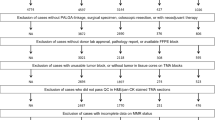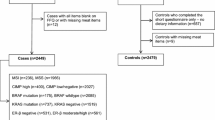Abstract
Diet and lifestyle factors have been inconsistently associated with rectal tumors. It is possible that evaluation of specific tumor markers with these factors may help clarify these associations. In this study, we examine energy contributing nutrients, dietary fiber, BMI (kg/m2), and long-term physical activity with TP53 mutations, KRAS2 mutations, and CpG Island Methylator Phenotype (CIMP) in 750 population-based cases of rectal cancer compared to healthy controls. We observed that high levels of physical activity reduced the risk of having TP53 and KRAS2 rectal tumor mutations. Dairy products rich in fat were associated with an increased risk of CIMP+ tumors (OR 1.88 95% CI 0.92, 3.84), while low-fat dairy products reduced risk of CIMP+ tumors (OR 0.56 95% CI 0.29, 1.09). Omega-3 fatty acids were associated with a twofold increased risk of a CIMP+ tumor. High levels of vegetable intake reduced risk of both TP53 mutations (OR 0.73 95% CI 0.54, 1.00; p trend 0.02) and KRAS2 mutations (OR 0.60 95% CI 0.40, 0.89; p trend <0.01). High intake of whole grains reduced the likelihood of a TP53 mutation (OR 0.74 95% CI 0.56, 0.99), while high intake of refined grains increased the likelihood of a TP53 mutation (OR 1.41 95% CI 1.02, 1.96). Dietary fiber also was associated with reduced risk of TP53 and KRAS2 rectal tumor mutations. Overall, a prudent dietary pattern significantly reduced the likelihood of a KRAS2 tumor mutation (OR 0.68 95% CI 0.47, 0.98; p linear trend 0.03). These data suggest that diet and lifestyle factors are associated with specific types of rectal tumor mutations and epigenetic changes. Findings need confirmation in other studies.
Similar content being viewed by others
References
Michels KB, Edward G, Joshipura KJ, Rosner BA, Stampfer MJ, Fuchs CS, Colditz GA, Speizer FE, Willett WC (2000) Prospective study of fruit and vegetable consumption and incidence of colon and rectal cancers. J Natl Cancer Inst 92:1740–1752
Voorrips LE, Goldbohm RA, van Poppel G, Sturmans F, Hermus RJ, van den Brandt PA (2000) Vegetable and fruit consumption and risks of colon and rectal cancer in a prospective cohort study: the Netherlands cohort study on diet and cancer. Am J Epidemiol 152:1081–1092
Slattery ML, Curtin KP, Edwards SL, Schaffer DM (2004) Plant foods, fiber, and rectal cancer. Am J Clin Nutr 79:274–281
Slattery ML, Neuhausen SL, Hoffman M, Caan B, Curtin K, Ma KN, Samowitz W (2004) Dietary calcium, vitamin D, VDR genotypes and colorectal cancer. Int J Cancer 111:750–756
Murtaugh MA, Ma KN, Sweeney C, Caan BJ, Slattery ML (2004) Meat consumption patterns and preparation, genetic variants of metabolic enzymes, and their association with rectal cancer in men and women. J Nutr 134:776–784
Slattery ML, Caan BJ, Benson J, Murtaugh M (2003) Energy balance and rectal cancer: an evaluation of energy intake, energy expenditure, and body mass index. Nutr Cancer 46:166–171
Osler M (1987) Obesity and cancer. A review of epidemiological studies on the relationship of obesity to cancer of the colon, rectum, prostate, breast, ovaries, and endometrium. Dan Med Bull 34:267–274
Mao Y, Pan S, Wen SW, Johnson KC (2003) Physical inactivity, energy intake, obesity and the risk of rectal cancer in Canada. Int J Cancer 105:831–837
Slattery ML, Edwards S, Curtin K, Ma K, Edwards R, Holubkov R, Schaffer D (2003) Physical activity and colorectal cancer. Am J Epidemiol 158:214–224
Deneo-Pellegrini H, Boffetta P, De Stefani E, Ronco A, Brennan P, Mendilaharsu M (2002) Plant foods and differences between colon and rectal cancers. Eur J Cancer Prev 11:369–375
Terry P, Baron JA, Bergkvist L, Holmberg L, Wolk A (2002) Dietary calcium and vitamin D intake and risk of colorectal cancer: a prospective cohort study in women. Nutr Cancer 43:39–46
Martinez ME, Willett WC (1998) Calcium, vitamin D, and colorectal cancer: a review of the epidemiologic evidence. Cancer Epidemiol Biomarkers Prev 7:163–168
Harriss DJ, Atkinson G, Batterham A, George K, Tim Cable N, Reilly T, Haboubi N, Renehan AG (2009) Lifestyle factors and colorectal cancer risk (2): a systematic review and meta-analysis of associations with leisure-time physical activity. Colorectal Dis
Howard RA, Freedman DM, Park Y, Hollenbeck A, Schatzkin A, Leitzmann MF (2008) Physical activity, sedentary behavior, and the risk of colon and rectal cancer in the NIH-AARP diet and health study. Cancer Causes Control 19:939–953
Moradi T, Gridley G, Bjork J, Dosemeci M, Ji BT, Berkel HJ, Lemeshow S (2008) Occupational physical activity and risk for cancer of the colon and rectum in Sweden among men and women by anatomic subsite. Eur J Cancer Prev 17:201–208
Friedenreich C, Norat T, Steindorf K, Boutron-Ruault MC, Pischon T, Mazuir M, Clavel-Chapelon F, Linseisen J, Boeing H, Bergman M, Johnsen NF, Tjonneland A et al (2006) Physical activity and risk of colon and rectal cancers: the European prospective investigation into cancer and nutrition. Cancer Epidemiol Biomarkers Prev 15:2398–2407
Larsson SC, Rutegard J, Bergkvist L, Wolk A (2006) Physical activity, obesity, and risk of colon and rectal cancer in a cohort of Swedish men. Eur J Cancer 42:2590–2597
Slattery ML, Murtaugh M, Caan B, Ma KN, Wolff R, Samowitz W (2004) Associations between BMI energy intake, energy expenditure, VDR genotype and colon and rectal cancers (United States). Cancer Causes Control 15:863–872
Slattery ML, Curtin K, Ma K, Edwards S, Schaffer D, Anderson K, Samowitz W (2002) Diet activity, and lifestyle associations with p53 mutations in colon tumors. Cancer Epidemiol Biomarkers Prev 11:541–548
Slattery ML, Anderson K, Curtin K, Ma KN, Schaffer D, Samowitz W (2001) Dietary intake and microsatellite instability in colon tumors. Int J Cancer 93:601–607
Slattery ML, Curtin K, Sweeney C, Levin TR, Potter J, Wolff RK, Albertsen H, Samowitz WS (2007) Diet and lifestyle factor associations with CpG island methylator phenotype and BRAF mutations in colon cancer. Int J Cancer 120:656–663
Slattery ML, Curtin K, Anderson K, Ma KN, Ballard L, Edwards S, Schaffer D, Potter J, Leppert M, Samowitz WS (2000) Associations between cigarette smoking, lifestyle factors, and microsatellite instability in colon tumors. J Natl Cancer Inst 92:1831–1836
Samowitz WS, Albertsen H, Sweeney C, Herrick J, Caan BJ, Anderson KE, Wolff RK, Slattery ML (2006) Association of smoking, CpG island methylator phenotype, and V600E BRAF mutations in colon cancer. J Natl Cancer Inst 98:1731–1738
Slattery ML, Potter J, Caan B, Edwards S, Coates A, Ma KN, Berry TD (1997) Energy balance and colon cancer—beyond physical activity. Cancer Res 57:75–80
Samowitz WS, Albertsen H, Herrick J, Levin TR, Sweeney C, Murtaugh MA, Wolff RK, Slattery ML (2005) Evaluation of a large, population-based sample supports a CpG island methylator phenotype in colon cancer. Gastroenterology 129:837–845
Issa JP, Shen L, Toyota M (2005) CIMP, at last. Gastroenterology 129:1121–1124
Frazier ML, Xi L, Zong J, Viscofsky N, Rashid A, Wu EF, Lynch PM, Amos CI, Issa JP (2003) Association of the CpG island methylator phenotype with family history of cancer in patients with colorectal cancer. Cancer Res 63:4805–4808
Park SJ, Rashid A, Lee JH, Kim SG, Hamilton SR, Wu TT (2003) Frequent CpG island methylation in serrated adenomas of the colorectum. Am J Pathol 162:815–822
Edwards S, Slattery ML, Mori M, Berry TD, Caan BJ, Palmer P, Potter JD (1994) Objective system for interviewer performance evaluation for use in epidemiologic studies. Am J Epidemiol 140:1020–1028
Slattery ML, Caan BJ, Duncan D, Berry TD, Coates A, Kerber R (1994) A computerized diet history questionnaire for epidemiologic studies. J Am Diet Assoc 94:761–766
Slattery ML, David R, Jacobs J (1995) Assessment of ability to recall physical activity of several years ago. Ann Epidemiol 5:292–296
Slattery ML, Edwards SL, Ma K-N, Friedman GD, Potter JD (1997) Physical activity and colon cancer: a public health perspective. Ann Epidemiol 7:137–145
McDonald A, Van Horn L, Slattery M, Hilner J, Bragg C, Caan B, Jacobs D Jr, Liu K, Hubert H, Gernhofer N, Betz E, Havlik D (1991) The CARDIA dietary history: development, implementation, and evaluation. J Am Diet Assoc 91:1104–1112
Liu K, Slattery M, Jacobs D Jr, Cutter G, McDonald A, Van Horn L, Hilner JE, Caan B, Bragg C, Dyer A et al (1994) A study of the reliability and comparative validity of the cardia dietary history. Ethn Dis 4:15–27
Slattery ML, Boucher KM, Caan BJ, Potter JD, Ma KN (1998) Eating patterns and risk of colon cancer. Am J Epidemiol 148:4–16
Slattery ML, Curtin K, Anderson K, Ma KN, Edwards S, Leppert M, Potter J, Schaffer D, Samowitz WS (2000) Associations between dietary intake and Ki-ras mutations in colon tumors: a population-based study. Cancer Res 60:6935–6941
Kuss O, McLerran D (2007) A note on the estimation of the multinomial logistic model with correlated responses in SAS. Comput Methods Programs Biomed 87:262–269
Burton P, Gurrin L, Sly P (1998) Extending the simple linear regression model to account for correlated responses: an introduction to generalized estimating equations and multi-level mixed modelling. Stat Med 17:1261–1291
Hofseth LJ, Saito S, Hussain SP, Espey MG, Miranda KM, Araki Y, Jhappan C, Higashimoto Y, He P, Linke SP, Quezado MM, Zurer I et al (2003) Nitric oxide-induced cellular stress and p53 activation in chronic inflammation. Proc Natl Acad Sci USA 100:143–148
Slattery ML, Wolff RK, Herrick J, Caan BJ, Samowitz W (2009) Tumor markers and rectal cancer: support for an inflammation-related pathway. Int J Cancer 125:1698–1704
Hussain SP, Harris CC (2007) Inflammation and cancer: an ancient link with novel potentials. Int J Cancer 121:2373–2380
Weijenberg MP, Luchtenborg M, de Goeij AF, Brink M, van Muijen GN, de Bruine AP, Goldbohm RA, van den Brandt PA (2007) Dietary fat and risk of colon and rectal cancer with aberrant MLH1 expression, APC or KRAS genes. Cancer Causes Control 18:865–879
Slattery ML, Caan B, Wolff R, KheNi MA, Samowitz W (2004) Association between dietary fats and VDR genotypes and colon and rectal cancer. International. Journal of Cancer Prevention 2:193–206
Slattery ML, Potter JD, Coates A, Ma KN, Berry TD, Duncan DM, Caan BJ (1997) Plant foods and colon cancer: an assessment of specific foods and their related nutrients (United States). Cancer Causes Control 8:575–590
Acknowledgments
We would like to acknowledge the contributions of Sandra Edwards, Leslie Palmer, and Judy Morse for the data collection and management efforts of this study and Erica Wolff and Michael Hoffman for genotyping, sequencing and methylation analysis. This study was funded by CA48998 and CA61757 to Dr. Slattery. This research was supported by the Utah Cancer Registry, which is funded by Contract #N01-PC-67000 from the National Cancer Institute, with additional support from the State of Utah Department of Health and the University of Utah, the Northern California Cancer Registry, and the Sacramento Tumor Registry. The contents of this manuscript are solely the responsibility of the authors and do not necessarily represent the official view of the National Cancer Institute
Author information
Authors and Affiliations
Corresponding author
Rights and permissions
About this article
Cite this article
Slattery, M.L., Curtin, K., Wolff, R.K. et al. Diet, physical activity, and body size associations with rectal tumor mutations and epigenetic changes. Cancer Causes Control 21, 1237–1245 (2010). https://doi.org/10.1007/s10552-010-9551-4
Received:
Accepted:
Published:
Issue Date:
DOI: https://doi.org/10.1007/s10552-010-9551-4




